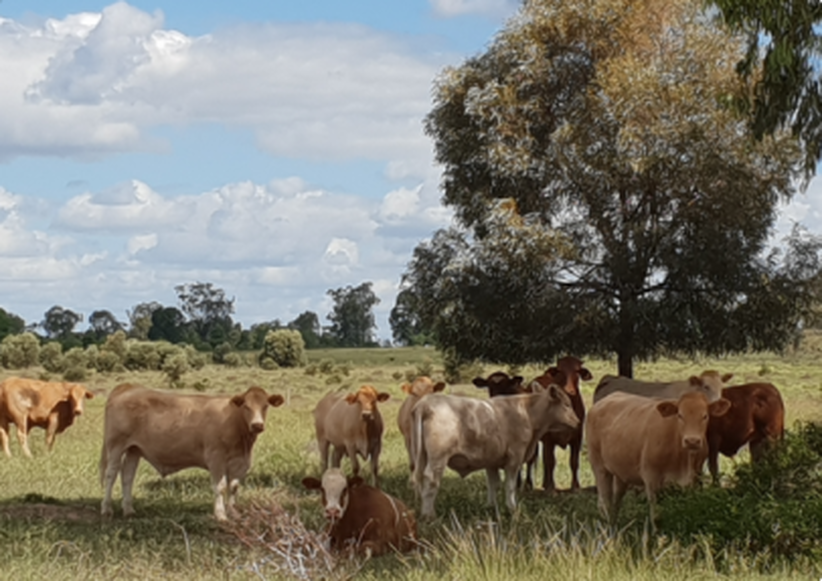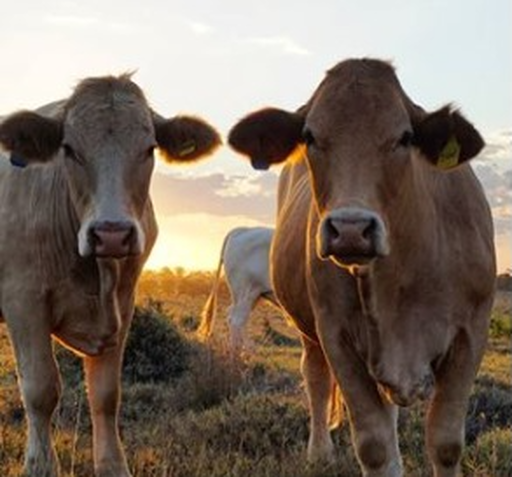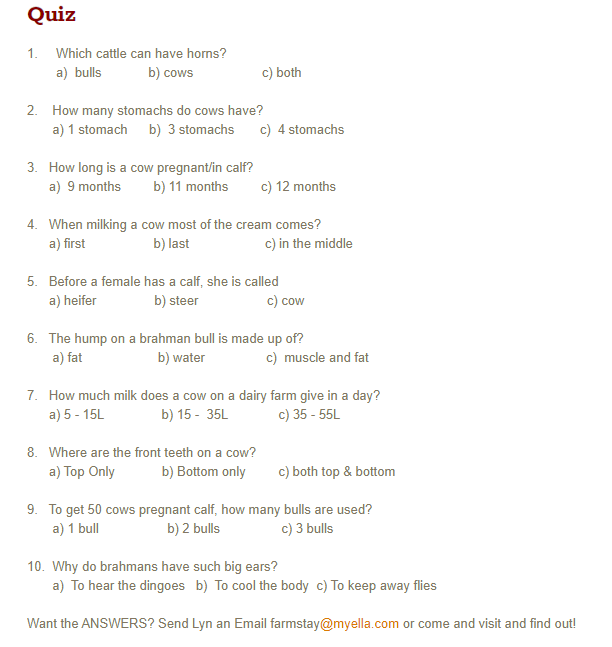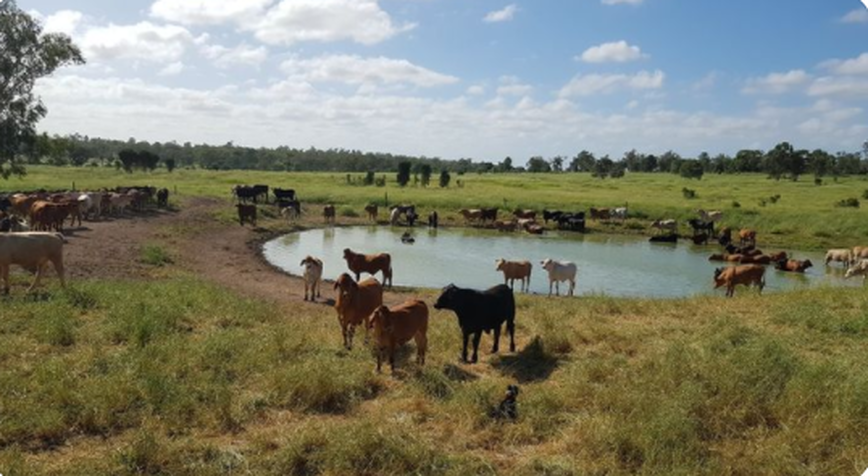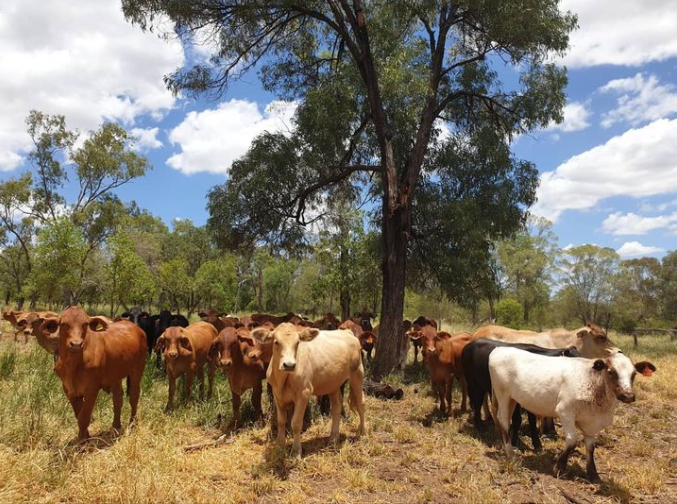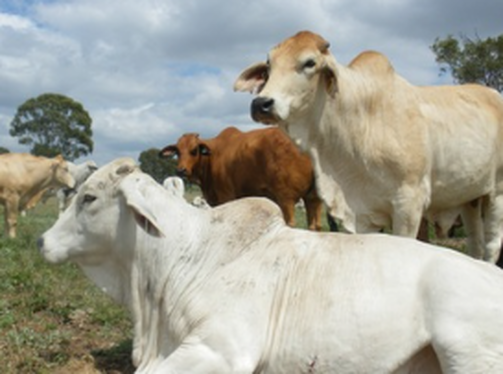Beef Cattle in Central Queensland
Did you know the cattle are micro-chipped with a NILS tag in their ear and they get vaccinated as well.
Life Cycle of Cattle
It is possible that a cow in Central Queensland is close to a human less than 20 times in it’s life. The cow is pregnant for 9 months and she gives birth out in the field, it can take 20 minutes. If the cow has trouble giving birth she is usually sold so it doesn’t happen again. When the calves are between 2-4 months old the farmer gathers them to the yards where the calves are caught for branding. The boys operation takes about 75 seconds where he is castrated, branded, inoculated, ear marked and de-horned. A girl is caught for about 60 seconds. They are then put back with their mothers and let free again.
Five months later they are gathered again. The calf is now 7-9 months old and his mother is heavily pregnant. The calf is separated from it’s mother, it’s called weaning. The weaners now live in the yard. The mothers milk dries up and her body begins preparing for the next calf.
Five months later they are gathered again. The calf is now 7-9 months old and his mother is heavily pregnant. The calf is separated from it’s mother, it’s called weaning. The weaners now live in the yard. The mothers milk dries up and her body begins preparing for the next calf.
These weaners now receive their education and quietening. They live in the stock yard for 3 - 7 days and they learn their way around. They are fed hay and the farmer escorts them out into a field to graze for a few hours every day. He rides his horse or motorbike and sometimes uses dogs to help and keeps them together. This process is called tailing out the weaners. They learn to be moved by humans and stopped from running away. When the education is complete this herd is released into a paddock.
Here at Myella we buy male cattle at 2 years old, they are mature but are thin. These steers arrive by truck from a store cattle sale. We brand them, then escort them to a field where they will graze on grass. We usually move them into a better field in a few months and we hope to fatten them in a year. At the end of their farm stay we gather them and select the fattest. They are put in a special field with good grass and a special tree called leucaena, which originates from Mexico. Leucaena is quality comparable to clover and is high in protein and minerals, it makes them grow fatter and their coat shinier. On arrival 64 steers can fit in the truck, but when they are sold only fit 44 bullocks fit in the truck.
We sell them to a fat cattle sale or direct to the abattoir, both are near Rockhampton. The beef is exported to Japan, Korea or America. The Japanese take the best meat and pay the most money. They are very selective and there are many deductions if the meat is bruised meat, too fat, not fat enough or if the beast is too old.
Here at Myella we buy male cattle at 2 years old, they are mature but are thin. These steers arrive by truck from a store cattle sale. We brand them, then escort them to a field where they will graze on grass. We usually move them into a better field in a few months and we hope to fatten them in a year. At the end of their farm stay we gather them and select the fattest. They are put in a special field with good grass and a special tree called leucaena, which originates from Mexico. Leucaena is quality comparable to clover and is high in protein and minerals, it makes them grow fatter and their coat shinier. On arrival 64 steers can fit in the truck, but when they are sold only fit 44 bullocks fit in the truck.
We sell them to a fat cattle sale or direct to the abattoir, both are near Rockhampton. The beef is exported to Japan, Korea or America. The Japanese take the best meat and pay the most money. They are very selective and there are many deductions if the meat is bruised meat, too fat, not fat enough or if the beast is too old.
Brahman Cattle from India
Brahman cattle originated from India and were introduced to Australia because they were better suited to hot and tropical climates by breeding zebu cattle to European beef cattle. One of the first Brahman cross animals in Central Queensland was taken to a cattle competition in the Rockhampton show. It was judged on its suitability for the export meat market.
The animal was first judged visually, and was said to be the least suitable for export. The second part of the judging required the animal to the slaughtered and judged on its meat quality. It was awarded second prize!
Brahman cattle have endured famine, insects, pests, diseases and extreme temperature throughout their evolution. The hybrid cross between Indian/USA and European is an effective breeding mix as they grow vigorously and are very common in Central Queensland.
The animal was first judged visually, and was said to be the least suitable for export. The second part of the judging required the animal to the slaughtered and judged on its meat quality. It was awarded second prize!
Brahman cattle have endured famine, insects, pests, diseases and extreme temperature throughout their evolution. The hybrid cross between Indian/USA and European is an effective breeding mix as they grow vigorously and are very common in Central Queensland.
Cattle production
Cattle production in Australia aligns with a ten year cycle of production (or expansion) and depletion (or liquidation). Australian cattle prices are primarily determined by supply (or availability) and demand and the cycle of herd expansion and liquidation. When supply of cattle is high, competition and prices are typically lower, and vice versa. Cattle prices are also influenced by other markets (US cattle market), climatic events (rainfall and drought) and the global supply and demand for cattle.
Environmental Impacts on Cycle
Whilst and ideal period of production should naturally follow on from herd rebuilding, local environmental conditions can greatly impact the length of these stages. Drought can severely impact supply fording a state of liquidation due to limited feed and farm cash flow and in Australia these droughts can last many years.
Widespread flooding will greatly improve feed conditions, but can also hinder farm access and transport options for months at a time.
Favourable conditions such as the timing of rainfall events can impact pasture availability and growth rates of calves and cattle and also affect conception rates.
Sorce: The Australian Livestock Export Corporation LIVECORP
There is more to come....this document is a work on progress.
Environmental Impacts on Cycle
Whilst and ideal period of production should naturally follow on from herd rebuilding, local environmental conditions can greatly impact the length of these stages. Drought can severely impact supply fording a state of liquidation due to limited feed and farm cash flow and in Australia these droughts can last many years.
Widespread flooding will greatly improve feed conditions, but can also hinder farm access and transport options for months at a time.
Favourable conditions such as the timing of rainfall events can impact pasture availability and growth rates of calves and cattle and also affect conception rates.
Sorce: The Australian Livestock Export Corporation LIVECORP
There is more to come....this document is a work on progress.

